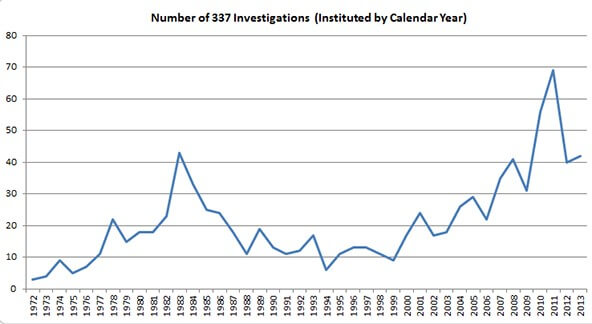Year: 2017
ITC Patent Litigation: Don’t Let Copycat Products Enter the USA

What do barcode readers, pool enclosures, televisions and backpack chairs all have in common? Each of these products has been investigated by a federal agency for unlawful importation into the United States. The unlawful part? They’ve all been charged with intellectual property infringement.
Section 337 and the ITC
The agency responsible for IP-based import investigations in the U.S. is the International Trade Commission (ITC). The piece of legislation that this agency deals with most often is Section 337 of Title 19. Section 337 prohibits the importation or sale of imported articles that infringe a valid and enforceable U.S. patent, trademark or copyright.
According to records maintained by the ITC, the amount of Section 337 investigations launched each year has been on the rise for the past 50 years:
- Before 1977 = less than 10 investigations launched per year
- 1978 = 22 investigations launched
- 1983 = 43 investigations launched
- 2011 = 69 investigations launched (record high)

In 2015, the most popular type of ITC investigation involved computer and telecommunications products. These products accounted for over a quarter (27%) of that year’s Section 337 investigations – the same amount as the next three product categories combined!
Opening an investigation
Nearly 90% of Section 337 investigations involve international patent infringement disputes. If a U.S. patent owner feels that a Section 337 violation has occurred, they can file a complaint with the ITC. The complaint will be reviewed by the ITC’s Office of Unfair Import Investigations (OUII), which will decide whether or not to launch an investigation. If an investigation is initiated, the ITC will publish a Notice of Investigation in the Federal Register.
Approximately 45% of Section 337 cases go to trial. These patent litigation trials typically take around 18 months to resolve and include the full range of court actions, including formal discovery, pretrial hearings and motions, trial by an Administrative Law Judge (no jury), post-trial briefs, Judge’s decision, ITC decision, and appeals.
Language challenges in ITC litigation
In ITC litigation, there is the additional challenge of working with one or more international parties. Discovery, in particular, can become a very complex and time-consuming process. For example, there can be hundreds or even thousands of patent documents in one or more foreign languages that require legal translation; depositions can take place all over the world; and everything needs to be translated into English for review by the ITC.
“Litigating in the ITC presents a unique challenge,” says Finnegan, a top IP law firm, because it involves solving “technologically complicated case[s] in a short period of time, in a pressure-packed forum that can make or break the commercial success of the products at issue.” In such an environment, seeking professional translation services to assist with cross-border discovery is no joke.
A language service provider (LSP) can utilize specialized tools and filtering techniques to cull large data sets into more manageable chunks of case-relevant information. Then machine translation (MT) can be used to determine the “gist” of what each document contains, so that it become clear which ones require more accurate human translation by subject matter experts (SME). This process guarantees accurate, high quality and fast translations, which are absolutely critical – anything less could have a serious impact on the outcome of the case.
Results of ITC litigation
Once the ITC Judge has reviewed all case information (with all legal documents translated into English) and heard both sides of the argument, he or she will rule on the case. Then, a Notice of Termination will be published in the Federal Register. If the Judge decides that a Section 337 violation did occur, the ITC can issue one or both of the following remedial orders:
- A cease-and-desist order against named importers – this type of order is enforced by the ITC.
- An exclusion order barring any further importation of the products at issue – this type of order is enforced by U.S. Customs and Border Protection. (You can view the current list of exclusion orders here.)
Importers who do not comply with a remedial order can face fines costing millions of dollars.
Get the latest insights delivered to your inbox
How to Globalize Video Marketing Through Translations

4x as many people prefer to watch videos about products than to read about them, and 40% say they are more likely to make a purchase on their phones if they watch a video first. Internet videos already reach more people than any individual U.S. cable network, and 75% of business executives watch work-related videos at least once a week.
YouTube, the largest video-sharing platform, accounts for more than a billion viewers and millions of viewing hours each day. Part of their effort to reach global viewers is comprehensive localization and translation of their user interface, with YouTube offering local services in 88 countries and in 76 languages.
Videos are clearly one of the most effective means of reaching global consumers. Ideally, they are entertaining and informative, engaging and immersive. Done right, and with the help of translation companies, videos should be an indispensable weapon in any marketer’s arsenal. The question is no longer whether or not to use videos – but how to make them cost-efficient and globally attractive in order to maximize your return on investment (ROI).
Why videos work
Videos can resonate with your target audience more effectively than any other medium. As marketing expert, Anne Hadley said, “Video adds a pulse to your content. It makes your story tangible and real. So why wouldn’t we all embrace it?” Especially when “embracing it” can translate directly into increased sales and market share. For example:
- Studies show that including video on a landing page can increase conversions by 80%. You can improve that rate even further by translating the website and landing page to appeal to an array of local audiences.
- Adding video to your translated website increases viewers’ time on-site and the likelihood that your website will appear on the first page of Google’s search results, a boon to your SEO efforts. (Search engines track the amount of time a visitor spends on a site before returning to the search results page. The more time someone spends on your site, the more relevant the link becomes to the search engine.)
- Sending an email with the word video in the subject line increases opens by 19% and click-throughs by 65%. It also reduces unsubscribes by 26%.
People are also much more likely to socially share video content over any other medium. Millennials, in particular, prefer to watch videos on their phones and are surprisingly likely to watch company videos when shopping online.
Video ROI and localization
While videos are clearly effective in boosting sales and brand recognition, they are also expensive. A great way to maximize ROI on a corporate video is to localize the content and distribute the video internationally, via social media to global audiences or directly to your employees or potential partners/investors overseas. But to avoid embarrassment and even potential liability, it’s critical to get your video professionally translated and localized.
Working with a language service provider (LSP) from the very beginning can help you determine how your message might be received in different locations, particularly those with distinct cultural differences. Ideally, this research should be conducted before the video is produced so that the content is appropriate for all intended audiences.
Strategies for localizing video
Targeting vastly different audiences with a single video is obviously not as effective as creating different versions for different audiences. But creating customized videos for each region is costly and may not always be an option. Here are three alternative strategies:
- Animation – Create a video that doesn’t rely on live actors. Animation can be engaging and has the advantage of narration – the narrator can speak in any language without needing to adjust the on-screen content to match.
- Dubbing – If actors are integral to the video, the next option to consider is dubbing. Voiceover talent records new dialogue in the target language that replaces the original spoken dialogue. Dubbing is a great way to localize your video for different audiences, but depending on the number of actors/voices in the video, it can be quite expensive.
- Subtitles – A third option is to use localized subtitles. This works for videos with or without actors. Subtitling is less expensive than dubbing and relatively easy to add to an existing video. The drawback, however, is that many viewers are reluctant to watch videos that require reading, and subtitles can distract from the visual message you are trying to convey. If your video is fast-paced, following the action and reading subtitles simultaneously might cause your intended audience to tune out.
Videos bridge the divide
Whether the videos are animated, dubbed, or subtitled, they are likely to be clicked and shared if they resonate with your target audience. In addition to obtaining professional subtitling or dubbing services, make sure to tackle issues of interest to the local audience and use cultural references that will appeal to your viewers. The more people feel represented in the videos, the more likely they are to share them.
Remember, ensuring cultural fluidity starts at the very beginning. A premiere LSP with proven video translation experience can help localize your content effectively so that it resonates with diverse audiences and even goes viral.
Get the latest insights delivered to your inbox
The Rise of Telehealth

If you watch any TV hospital dramas, you may have seen this already – a talking robot wandering the halls controlled by a remote doctor who is pictured on a computer screen at the head of the robot. These machines may look odd, but they are going to get a lot more popular over the next few decades. Telehealth is one of the most effective ways to increase health care availability throughout the United States, especially in rural and isolated communities where good doctors are hard to find.
What is telehealth?
Remote-controlled robots are one (pretty neat) aspect of telehealth, but the term covers much more than that. The U.S. Department of Health and Human Services defines it as “the use of electronic information and telecommunications technologies to support and promote long-distance clinical health care, patient and professional health-related education, public health and health administration.”
Modalities of telehealth
There are four main ways to implement telehealth services:
- Live video – Real-time interaction between a patient or caregiver and a medical specialist. This can include remote diagnosis, treatment or follow-up.
- Store-and-forward – Pre-recorded videos or images that are sent through a secure connection to a remote specialist who evaluates the information and sends a response back through the secure system.
- Remote patient monitoring (RPM) – Medical staff give a monitoring device to a patient, who can use it to record health and medical data from home. The data is transmitted on a regular basis (sometimes daily or hourly) to the medical provider for continuous monitoring and support.
- Mobile health (mHealth) – Combines health care services and education with mobile applications, such as targeted text messages, emails or alerts.
Benefits
Telehealth brings experienced medical care right into patients’ homes, or at least their hometowns. This is a huge plus for patients because:
- They gain access to medical experts in cities they can’t travel to due to mobility issues or financial hardship – a critical factor for the 16% of Americans who live in rural areas.
- Doctors and medical service providers can monitor patients without the need for in-office appointments – and the co-pays that go along with them.
- Educational tools and support are available at the touch of a button.
Physician shortage
The benefits of telehealth will become increasingly important as we get closer to 2025. By this time, the Association of American Medical Colleges (AAMC) predicts there could be a shortage of up to 94,700 physicians in the United States. The aging “Baby Boomer” population, in particular, will have a major impact on the medical industry over the next few years. Not only will the need for senior services increase, but the supply of caregivers will simultaneously decrease because over one-third of all current physicians are expected to retire in the next decade. “Physicians between ages 65 and 75 account for 11% of the active workforce, and those between ages 55 and 64 make up nearly 26% of the active workforce,” the AAMC reports. As the ratio of doctors to patients decreases, the appropriate use of technology in patient care will help close the gap and allow doctors to save in-office appointments only for those patients who truly need it.
Language challenges
Any hospital or health care facility that receives federal funding is required to offer language access programs for patients who don’t speak English fluently. With nearly 1 in 5 U.S. residents speaking a foreign language in their homes (Spanish and Chinese are the most popular), the implementation of increased telehealth services needs to take patients’ language needs into account. Telehealth services will need to incorporate translated websites, mobile apps and communications, medical documents and devices, as well as simultaneous interpretation of live video through on-site medical interpreters. One alternative to translating healthcare apps is to use pictures and icons. However, even these must take cultural differences into consideration.
What are my options?
Check with your health care provider to see what telehealth services they have available. You can use patient-focused technologies to take greater control of your own health. Even if you’re not ready to talk to a doctor through a robot head computer screen, there could be other telehealth resources that could help you in your day-to-day life (e.g. educational websites, automated appointment reminders, newsletters that are specific to your health needs, and more). With demands increasing on the healthcare system and a growing shortage of healthcare professionals, telehealth services could be your best bet for quality local care at a reasonable cost.
Get the latest insights delivered to your inbox
5 Best Uses of Tech for Law Firms

Technology has completely transformed how we do business. IT has changed how companies connect and communicate with their clients, and a company’s “storefront” online is now just as important as its physical office space. This is just as true for law firms as it is for any other business. Modern applications of technology can bring in new clients and help with expanding clientele, increasing revenue, and even improving internal engagement from your own team. Here are 5 great ways to use tech to generate new business and improve efficiency at your law firm:
1. Build a client portal
Static websites are old news. To optimize legal business today, you need to offer your clients this critical business tool. A portal allows clients to login to a customized section of your website where they can view, change and manage current and future projects. You determine what your clients have access to and when they have access to it. For example, a portal can include meeting calendars, document sharing, contact management and private messaging services.
Tip: Adding a client portal to your website makes collaboration easier and provides 24/7 access for your clients.
2. Write a blog
Become a resource for potential clients. Law firms are setting themselves apart by establishing a knowledgeable and impressive online presence. By covering important issues and addressing relevant or newsworthy topics, you can engage new readers and expand brand awareness for your firm. High quality original content will increase your visibility as your readers do the marketing for you by sharing it on LinkedIn, Facebook or via email. As more readers turn to your blog for answers and advice, some will inevitably bring in new business – either via referral or by becoming new clients themselves. And from a technical perspective, the more you blog, the more pages and links will be indexed by search engines – which increases the chances of your firm showing up on page 1 of online search results.
Tip: If your firm starts a weekly blog, after 1 year you can expect your website traffic to increase by 53%.
3. Create an app
The days of handing out flyers and printed ads are coming to an end. Today, the best way to communicate with your clients is through their mobile device. According to the Pew Research Center, 77% of Americans own smartphones – and the time we spend using them is up to 5 hours per day (that’s more time than we spend watching TV). If your firm doesn’t have a mobile interface, you’re missing a major opportunity to communicate with existing and potential new clients. You can start by creating an app with a simple menu – e.g. background information on the firm, contact us page and access to the firm’s blog. From there you can get creative and build out all kinds of innovative new features. For example, a services page with a fee calculator or a community page for legal questions and comments – the possibilities are endless.
Tip: Annual maintenance costs of a published app can be around 20% of your app’s initial development costs.
4. Accelerate review
Most major law firms already rely on e-Discovery software, such as kCura’s Relativity platform, to accelerate review and manage large volumes of data. These programs can assist with matters related to litigation, internal investigation, compliance, etc. You can get more out of legal software by utilizing the available plug-ins. For example, Morningside’s Language Connect plug-in helps expedite the translation of foreign language documents by allowing users to instantly send multilingual files for evaluation and translation without leaving the Relativity environment. Human, machine or hybrid translation services are available in more than 100 languages through Language Connect.
Tip: IBM has built an AI program named “Ross” that you can hire to do legal research for your firm.
5. Streamline compliance
Use certified eLearning training programs to take the place of in-person CLE or CPD seminars. These online courses are much more convenient for lawyers and their staff. As long as they have internet access, eLearning can be done anytime, anywhere, and in any language. By providing automated, easy-to-access and interactive training courses, employees are more likely to retain new knowledge and compliance officers can more easily track and monitor course completions.
Tip: If you are a multinational firm with a global workforce, translating onboarding and compliance materials often yields higher profits for the firm.
Get the latest insights delivered to your inbox
Indian English 101

Is that girl eating your brain? No, she’s not a zombie. That’s Indian English for “is she bothering you?” The same words we use in the United States can have very different meanings in India, where English is spoken by over 125 million people. Some phrases are unique combinations of English words that are not used outside of India, while others utilize the same words but have a very different context.
Where did the unusual words and phrases of Indian English come from? Here is a brief history: The English language arrived in India in the early 1600s with the start of British colonization. Initially, Christian missionaries were the only English teachers around. Over the course of the next two centuries, English increasingly became the language of higher education, government administration, the media and the social elite. After Indian independence in 1947, India declared Hindi its official language. However, with 18 other national languages and hundreds of different dialects, English remained a popular second language. It was seen as a language of opportunity for those seeking social mobility, while simultaneously serving as a common language for Indians from different regions who spoke mutually unintelligible languages.
After nearly 400 years of use on the subcontinent, Indian English has morphed into its own unique dialect. Here is our brief introduction to words and phrases in Indian English that might look familiar, but have very different meanings.
Words or phrases that have different meanings in Indian English
- At the rate = the @ sign. Example: My mail ID is Sirena at the rate Morningside dot com.
- Belong to = am from. Example: Where are you from? I belong to Delhi.
- Crib = complain. Example: She won’t stop cribbing about her mother-in-law.
- Doubt = question. Example: Please Miss, I have a doubt.
- Flick = steal. Example: Someone flicked my phone on the train.
- Good name = first name
- Got fired = got yelled at
- Graduation = studied for a degree. Example: I did my graduation at the University of Delhi.
- Mail = email
- Mail ID = email address
- Mug up = cram or study intensively. Example: Tonight, I need to mug up for my final exam.
- Out of station = out of town
- Passed out = graduated. Example: I passed out of college.
- Saloon = hair salon or barbershop
- Visiting card = business card
Words or phrases unique to Indian English
- Airdash = to take a quick (sometimes emergency) flight
- Batchmate = a member of the same graduating class
- Convent-educated = educated in English (from when teaching used to be done by clergy members)
- Cooling glass = sunglasses
- Eating my brain = really bothering me
- Foreign-returned = having returned to India after studying or living abroad
- Freeship = full scholarship or payment for university
- Godown = a warehouse
- Incharge = a manager or supervisor
- Level best = very best effort
- Petrol bunk = gas station
- Prepone = reschedule something to an earlier date
- Rowdy-sheeter = a person who has a criminal record
- Sitting on my head = stressing me out
- Unmotorable = a road that isn’t suitable for use by motor vehicles
Get the latest insights delivered to your inbox
2016 Immigration Court Trends

Each year, the DOJ’s Executive Office for Immigration Review publishes a Statistics Yearbook on immigration court matters. The FY 2016 Yearbook was released last month, highlighting several significant trends. For example:
- 14% more matters were received by Immigration Courts in 2016 compared to 2015.
- 25% of all matters received came into the court systems of LA, NYC, San Francisco, Arlington (VA) or Miami.
- 76% of all matters completed were conducted in Spanish.
To learn more about key immigration court trends in 2016, check out our infographic below:

Get the latest insights delivered to your inbox
Translating Pharma Research During Global Clinical Trials

Virtually half of the clinical trials in life sciences today take place outside of the US, and a majority of trials regulated by the US Food and Drug Administration (FDA) are held abroad—mostly in developing countries.
One big reason for outsourcing clinical trials to developing countries is that it can save pharmaceutical companies as much as 90% on the cost of clinical staff at the testing facilities. Another important reason for outsourcing is to ensure that drugs are effective across different ethnic groups. The greater the diversity of the testing subjects, the more reliable the results will be for companies seeking to market their products to different populations across the world.
Testing pharmaceuticals on human subjects always requires great care and precision. When these tests are held in foreign countries with diverse languages and cultures, an entirely new set of challenges will arise for the study sponsor: All vital documents will require translation—either via a medical translator or a medical translation service.
Accuracy is critical
All of the collected information, including recruitment materials, informed consent forms, patient questionnaires, and case report forms must be translated into the local language and the results translated back into English to allow researchers to analyze the information.
This kind of translation leaves no room for error. If the forms are mistranslated, thousands of patient results could contain incorrect data. Regulatory submissions could become compromised, delaying review and approval. Every effort must be made to ensure error-free deliverables in order to maintain the integrity of the study.
Potential challenges
Two of the main translation challenges that arise when a test subject speaks a different language from the researcher are:
- Gaining conceptual equivalence — Infusing cultural meaning into translations. It’s not enough to simply understand the test subject’s language; a familiarity with their culture is necessary to convey the connotations behind specific words and phrases. This is particularly important when it comes to patient diaries, questionnaires, and other materials where understanding the cultural context of what the subject is saying is of utmost importance.
- Expressing intention — It’s vital to ensure that translations reflect what the subject intended to express. When a translation is too literal, it risks leaving out some of the intended meaning.
Industry guidelines
The International Society for Pharmacoeconomics and Outcomes Research (ISPOR) has released two reports on best practices for translations of:
Both reports address ways to improve translations and cultural adaptations in clinical trials. One key finding was the need for a separate process for medical translation from one language to another, versus same-language translations such as converting Spanish spoken in Spain to Spanish spoken in Argentina.
LSP assistance
Moving clinical trials overseas has helped pharmaceutical companies save money, increase diversity amongst research participants, and open new markets for industry products. The process, however, has placed translations in the spotlight. Using a professional medical translation service can remove the related stress by ensuring 100% accurate translations of clinical trials – no matter where they take place or in what language.
Get the latest insights delivered to your inbox
4 Fields That Require Professional Translation Services

Translations play a key role in global success for any business. No matter your industry, professional translation is crucial for a variety of purposes, ranging from marketing and HR to global clinical trials and e-discovery.
Given the connected nature of the international marketplace, it is no longer sufficient to restrict business materials to English, especially if you are looking to expand your brand and product overseas. Translating materials not only functions as a boon to accessing a regional market – in certain countries, translations are required to meet local regulatory and compliance mandates. Translations also offer spillover benefits, such as improving global workforce engagement.
Enlisting a professional language service provider (LSP) will allow you to enjoy all the advantages of accessing a global audience, and growing your international presence.
1. International Litigation
International litigation is highly complex on its own. Add in the language, cultural, regulatory and procedural differences, and the experience can begin to feel overwhelming. Regulations are susceptible to change, even on a single-word basis, and mountains of discovery materials often include foreign language documents. Unless these are all translated appropriately, the likelihood of a transnational miscommunication is high.
There are three instances, in particular, where legal translations come in handy:
- Cases heard in multiple courts, in different nations.
- Staff are not fluent in the necessary language for an international case.
- A law exists in another language, but is required for use or application.
Given the high level of specificity within law code, there is little-to-no room for error when it comes to translations. Therefore, it’s important to ensure translators are ISO-certified.
2. Marketing & E-Commerce
The proliferation of digital devices and solutions across the world have encouraged businesses to go global. Conducting business on a global scale means interacting with different languages and cultures while creating websites, brochures, advertisements, contracts, commercial agreements, quarterly and annual reports, etc. Whatever industry you’re in, communicating the proper message abroad is crucial.
This is perhaps the most apparent in the realm of ecommerce. At the beginning of 2016, reports showed that 57% of participants across six continents purchased an item from a website based overseas. By the end of that same year, the U.S. ecommerce market had accrued over $322 billion in revenue, with projections indicating sustained growth. To enjoy numbers like that, ecommerce businesses have to market to different regional audiences. With English spoken by only 26% of the world’s internet users, localization and translation have become critical tools for successful international business adaptation.
3. Global Clinical Trials & Research Publications
Translation takes a prominent role in the medical industry when it comes to conducting global clinical trials and publishing scientific papers.
- Clinical trials require an immense amount of paperwork. There are documents that have to be filled out by patients (informed consent forms), administering staff (case report forms), doctors (clinical outcome assessments), and more. If the research sponsor is conducting global clinical trials, then all of these documents need to be translated for each location – twice. The documents need to be translated from the original language into the local language of the test participants. Once everything has been recorded, it has be to translated back into the original language of the research sponsor. Throughout this complicated process, expert linguists should be on staff to answer questions.
- 75% of scientific papers are written in English, with some fields reaching as high as 90% in English. As such, non-English research must be translated in order to reach the rest of the scientific community.
4. Patent Filing
Filing a patent application anywhere is a highly complex process. It’s even more complicated when you’re applying for a patent in a different language under a different set of regulations. Similar to the legal industry, accuracy and compliance are critical due to the highly technical and precise language of patent applications.
Filing and maintaining a patent application in major international markets can range from around $11,400 in Israel to nearly $25,700 in Japan. As international filing increases, translation prices have also increased. According to the European Commission (EC), “the costs for a single translation of a patent may be more than €1500.” When you add the cost of translations in multiple languages and filing fees for multiple countries, the EC says “national validation costs can add up to about 40% of the overall costs of patenting in Europe.”
Working with a language service provider can help reduce costs and verify accuracy throughout the patent application process. In a recent IP Watchdog webinar on patent filing, Morningside IP’s Rob Bloom explained, “Since Morningside IP represents hundreds of clients, our foreign associates offer us a much more competitive fee structure than an individual organization with an IP portfolio could obtain.”
Work with an LSP from the start
Using a faulty or inaccurate translation in any of the above industries could lead to a lengthy and expensive repositioning of your international business. Instead, use a professional Language Service Provider from the start of your venture to seamlessly integrate the various regions of your global business.
Get the latest insights delivered to your inbox
The Right to Know: Translating Informed Consent

Informed consent is a basic human right. Therefore, risks must be made clear to participants of clinical trials or those undergoing surgical procedures. To ensure these basic rights are protected, the US Food and Drug Administration (FDA) mandates the use of informed consent forms (ICFs).
An ICF must include a range of information to minimize liability – and it must be written in a language that the subject understands. If the subject does not understand English well enough to give informed consent, the Institutional Review Board (IRB) mandates that the form must be translated by a medical translation professional. It is critical that the subject has a clear understanding of the risks and responsibilities of participating in a clinical trial.
Carrying out a procedure or clinical study without obtaining informed consent can expose medical professionals to a host of ethical challenges, malpractice suits or even charges of assault.
Defining informed consent
Informed consent is the process between a patient and a medical professional that provides the patient with the information necessary to determine the risks of undergoing a specific procedure or test. The informed consent process includes follow-up discussions to clarify ambiguities and ask questions, and should give patients ample time to make thoughtful decisions.
After the subject reviews the relevant information, he or she must sign the ICF. In cases where there is a reasonable expectation that non-English speakers will participate in a trial, the clinical investigator must submit the translated informed consent documents to the IRB before starting the consent procedure. After signing, the entire process comes under review again by the IRB, which is charged by the FDA to “protect the rights and welfare of subjects participating in clinical investigations.”
Elements an ICF must include
The following eight ICF components are required by the FDA – and must be written in the participant’s mother tongue or an officially acceptable translation – to earn IRB approval:
1. Description of Clinical Investigation – Subjects must be provided with an explanation of the research being conducted, its purpose, length of trial, and how it will be carried out (including any experimental procedures).
2. Risks and Discomforts – The subject must be informed of any foreseeable risks, danger or discomfort, including the severity of pain from a surgical procedure, recovery time, or even standard tests.
3. Benefits – The subject must receive a full description of how the experimental treatment could benefit them and/or others. The description should be clear, realistic and not overly optimistic.
4. Alternative Procedures or Treatments – The subject must be made aware of other options to treat their medical problem/s. The risks and benefits of those options must be fully explained.
5. Confidentiality – Subjects must be informed about who will have access to confidential medical records (e.g. the study sponsor), the degree of confidentiality they can expect, and under what circumstances the records would be turned over to a third party. In all cases, the FDA may inspect medical records (permission from the subject is not necessary).
6. Compensation and Medical Treatment in the Event of Injury – When there is more than minimal risk, subjects must be clear on what compensation and medical treatment, if any, may be obtained in the event of injury. Circumstances under which no compensation or treatment is available must be clearly expressed.
7. Contacts – Information must be provided regarding who to contact for further inquiries or complaints. The contact person should not be a member of the clinical team carrying out the trial so that the subject feels comfortable making a complaint or inquiry.
8. Voluntary Participation – Subjects must be made aware that they will not suffer any penalty or lose benefits they are entitled to by withdrawing from the study at any time. In addition, if withdrawal entails special procedures, those must be outlined in detail. It is important to note, however, that any data collected about a subject prior to their withdrawal is still fair game for inclusion in the study.
Other elements, when appropriate, should inform the subject of unforeseeable risks, circumstances under which the study leader may terminate participation, additional costs, and new, relevant research.
Exculpatory language is not permissible anywhere on an ICF form. This kind of language allows the individual to waive their legal rights, releasing the research sponsor (or its agents) from liability for malpractice or negligence (e.g. compensation for research-related injury).
The responsibility of ensuring informed consent
Responsibility for ensuring informed consent falls to three parties – the IRB, the clinical investigator, and the research sponsor. The three-pronged system ensures that the patient is protected from coercion or pressure to participate against his or her will. For example:
- A manufacturer wants to produce a new drug or medical device. They decide to sponsor a research project involving human subjects. They become responsible for “assuring the FDA that a study will be conducted in compliance with the informed consent and IRB regulations.”
- The sponsor hires a clinical investigator (and staff) and makes them sign specific forms (e.g. FDA-1572) or agreements promising to have the study reviewed by an IRB. From that point forward, the clinical investigator usually acts as the main point of communication between the IRB and the research sponsor.
- The IRB reviews all the materials to be signed by the research subjects, including officially translated versions of the ICF, before the consent process begins. Once everything is IRB-approved, it becomes the clinical investigator’s direct responsibility to collect ICFs from every research subject.
Translating for non-English speaking subjects
Ethically, scientific research should be carried out independent of considerations about the predominant language in a particular area. People who speak other languages should be neither targeted nor excluded. In order for foreign language speakers to make an informed decision, translation requirements dictate that all of the relevant consent forms must be delivered at the subject’s level of understanding (without medical jargon) in a language they speak fluently. For studies that pose more than minimal risk to subjects, ICF translations must be performed by a professional medical translator or a qualified Language Services Provider (LSP) that relies on medical translation professionals.
When to use a qualified LSP
A qualified translator must be retained if:
- A subject does not understand English but is literate in other languages. In this case, a written ICF must be provided in a language that the participant understands and a translator must be provided who is fluent in English and the participant’s spoken language.
- A subject does not understand English and is illiterate in other languages. In this case, an oral explanation must be given in the subject’s language. A witness must be present, and a short form in the subject’s language and a detailed long form on the oral presentation are required.
The essence of personal autonomy
Medical trials go to the very heart of personal autonomy. The law ensures that no one should ever be subject to medical experimentation without full understanding of the risks, benefits, alternatives, and procedures.
The FDA provides clear directions for ensuring that the necessary information is presented in an understandable manner. To minimize liability, clinical trials must adhere to the FDA’s guidelines as closely as possible, including ensuring that informed consent forms are handled by medical translation professionals.
Get the latest insights delivered to your inbox
Is Website Translation Proxy Right for You?

If you want to communicate with a global audience, strengthen your brand or market your product overseas, it’s critical that you translate your website and update the foreign-language versions as often as possible. This is easier said than done, especially if your website has many pages of content and needs to be translated into several languages. If this describes your situation, you should consider a Translation Proxy Service (TPS) to help you simplify the website translation process and manage the foreign-language versions of your website with greater ease.
What is translation proxy?
A translation proxy server is a dedicated computer or software system that acts as an intermediary between your original English website and the foreign-language versions of your website. The proxy works as a layer on top of the original website that dynamically swaps English content for the translated content that your end users need. Instead of localizing the content within your CMS (Content Management System), this content is pulled from translation memory stored in the TPS repository for your website. This system allows your end users to browse online content in their own language without you needing to re-translate every page. As long as the content has already been translated in the past, the translation proxy can fetch the content and make it available to your foreign visitors.
Is website translation proxy right for you?
TPS works best for translating mirror-image websites – i.e. those that don’t require significant changes in layout, style, colors, etc. For example, if your company is selling its products in the U.S. and China, the product configurations might differ by country – requiring two different versions of the same website page. Such a scenario isn’t ideal for TPS. TPS works best when the same content will be used in many regions. TPS mirrors your site’s structure and needs the same content for all the different languages you want to translate into.
What are the benefits of a TPS?
Assuming your web content doesn’t need to be adapted for specific regions around the globe, TPS has five key benefits to make your life easier:
- Reduced site administration – Since TPS crawls and extracts all your site’s content automatically, it saves a lot of effort for your site administrator. Other translation options may require your site admin to manually save or copy content to make it available for translation, and then manually copy or import back into your site. Factor this across multiple languages and the whole process can become difficult and time-consuming to manage.
- Automatic change detection – A big part of site administration is managing updates. Even with a highly robust Content Management System (CMS), it still requires a lot of effort to get content changes entered and deployed in just your original (English language) site. TPS can manage changes automatically, since it is based on a system that scans your site. A capable TPS system can detect changes on a page as well as the addition and deletion of other pages.
- Simplified translation workflow – Related to automatic change detection is the ability to easily process translation updates using TPS. Most TPS systems offer a turn-key way to process translation updates by utilizing human translators, machine translation or a combination of both. If any system requires you to touch translated content to publish it, look elsewhere!
- Minimal hosting cost – This is an aspect of TPS that may vary by provider. Customized systems that you need to deploy on your infrastructure can be quite expensive to install and configure, and may even require additional servers and storage space. Cloud-based TPS systems do exist. Those that utilize well-established architecture, such as Google AppEdge servers, carry a much lower cost, which is tied to how much content you are hosting in the TPS and how many page views you get per month on the stored pages. This kind of metered option is ideal, since you only pay for what you use.
- Benefits of a Content Delivery Network – Another feature of some TPS systems is Content Delivery Networks (CDN) to deliver your content over the web. A CDN is a network of proxy servers that ensure faster delivery of content by caching copies of a site’s contents on multiple servers closer to the users accessing that content. This content delivery strategy provides a better user experience and it builds redundancy into the system, so that if one server goes down another can still deliver the content.
Optimizing your website
Hopefully this article has provided a good basis to help you decide if TPS is the right technology for your company’s multilingual website. TPS can help simplify the website translation process and streamline the creation and management of foreign-language versions of your site.
If you would like to learn more about whether a translation proxy solution is right for you, contact us today.

